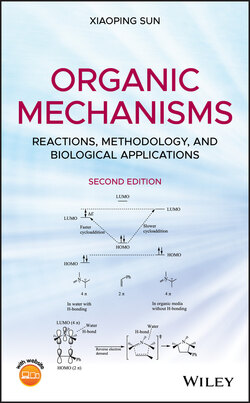Читать книгу Organic Mechanisms - Xiaoping Sun - Страница 39
1.12 THE GREEN CHEMISTRY METHODOLOGY
ОглавлениеTraditionally, synthesis of organic compounds has been performed very commonly in various organic solvents to make homogeneous reactions occur because many organic reactants are hydrophobic (water insoluble), but lipophilic (soluble in “oil”—the organic media). Organic solvents are in general hazardous substances. Utilization of large amounts of toxic organic solvents in synthetic reactions has created a big burden to the environment. The ideal green synthesis of organic compounds should avoid utilization of any solvents or only include environmentally benign solvents in the reactions, among which the most convenient, most natural, and cheapest is water. Conducting organic reactions in (or on) water will minimize the difficulty in the waste disposal, greatly reduce the pollution of the environment with hazardous materials, and ease the product work‐up and separation. This protocol has received much attention from organic chemists in the past 15 years [9, 10]. Many synthetic reactions performed in water heterogeneously have been found substantially faster than the reactions traditionally carried out in organic solvents [9–12]. Effective and efficient organic synthesis in water represents a major aspect of methodology in the current green chemistry.
FIGURE 1.23 Comparison of energetics for the concerted and the enzyme (carbonic anhydrase) catalyzed stepwise reactions of H2O and CO2 giving HCO3−.
Research by vibrational sum frequency (VSF) spectroscopy has shown that on the hydrophobic interface between water and an organic layer, such as CCl4 and hexane, the intermolecular hydrogen bonding between water molecules is substantially weaker than the hydrogen bonds of water in the liquid–vapor interface and inside the liquid phase of water. This is indicated by a blue shift of the vibrational bands for hydrogen bonded water in H2O/CCl4 and H2O/hexane interfaces relative to that for the water in the liquid–vapor interface [13]. This weakening in hydrogen bonding allows water molecules in the interface to move more freely and gives rise to strong orientation effects of water on the hydrophobic interface, such that the O─H bond in some water molecules (1 in 4 H2O molecules) on the hydrophobic interface penetrates into the organic layer [9, 14]. In the cases of the heterogeneous organic reactions performed in water, if a reactant molecule can act as a hydrogen bond acceptor, the OH bond in water which penetrates into the organic layer can form a strong hydrogen bond with the reactant molecule and more importantly, form a strong hydrogen bond with the transition state of the reaction to stabilize the transition state and lower the activation energy [9, 14]. In addition, upon vigorous agitation of the reaction mixtures in water, the bulk organic phase can be separated into aggregates (droplets) by water. Formation of aggregates increases surface area of the reactants and therefore, enhances their energy to lower the activation energy as well [9]. As a result, the reactions that take place on the hydrophobic interface (heterogeneous reactions) become much faster than the homogenous reactions occurring in organic solvents or in neat reactants [9, 14]. The hydrophobic effects are summarized in Figure 1.24. This way water is not only used as a green solvent, but it also acts as an effective “catalyst” to speed up the reactions.
Figure 1.24a illustrates that a free OH bond in a water molecule of the hydrophobic interface partially penetrates into the organic layer and is hydrogen bonded to the transition state (via a hydrogen bond acceptor) of a reaction taking place in the organic phase. This water molecule is also hydrogen bonded to other water molecules (denoted by W) inside the water phase. The hydrogen in the free OH bond acts as a nearly bare proton. Therefore, the hydrogen bond formed on the transition state is strong, greatly stabilizing the transition state (Fig. 1.24b). [TS]Oǂ and [TS]Wǂ represent the transition states for the reactions taking place in organic media (homogeneous) and in hydrophobic water/organic interface (heterogeneous), respectively. Ea,O and Ea,W are the corresponding activation energies for the homogeneous and heterogeneous reactions (Ea,W < Ea,O), respectively. Both aggregation of the organic reactants and especially, the hydrogen‐bond stabilization for the transition state result in decrease in the activation energies of the organic reactions on the hydrophobic interface and greatly speed up the reactions relative to those performed in organic media.
FIGURE 1.24 Hydrophobic effects on organic reactions. (a) The intermolecular hydrogen bond between water and transition state of reactions taking place in the hydrophobic interface, and (b) comparison of the energetics for the homogeneous reactions (Ea,O and [TS]Oǂ) in organic media and heterogeneous reactions (Ea,W and [TS]Wǂ) in the water–organic interface.
Many types of organic reactions, such as Diels–Alder cycloadditions and Claisen rearrangements, have been carried out in water with fast speeds and good yields [9–12]:
(1.74)
For example, it only takes 10 min for Reaction 1.74 to complete in water as the reaction mixture is vigorously agitated at 23 °C. When the reaction is performed by neat reactants with no solvent, the completion time is 48 h. It takes more than 120 h for the same reaction to complete in toluene homogeneously [12].
(1.75)
The rate constant for Reaction 1.75 performed in water (kwater) is many times greater than the rate constants for the reaction performed in organic solvents (ksolvent). Research has shown that the kwater/ksolvent ratios at room temperature for isooctane, acetonitrile, and methanol are 740, 290, and 58, respectively [9].
More examples and mechanistic details of organic reactions carried out in water will be discussed in individual chapters (Chapters 4, 8, and 10) in the sections of green chemistry methods and applications.
